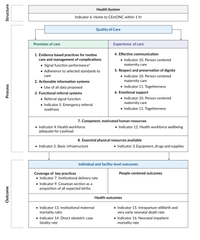Exploring quality of care with the EmONC indicators
The EmONC Framework is designed to help countries identify and prioritize areas for action that are needed to ensure good quality of EmONC. The WHO defines quality of care as:
“the extent to which health care services provided to individuals and patient populations improve desired health outcomes. In order to achieve this, health care must be safe, effective, timely, efficient, equitable and people-centered.”1 “The quality of care for women and newborns is therefore the degree to which maternal and newborn health services (for individuals and populations) increase the likelihood of timely, appropriate care for the purpose of achieving desired outcomes that are both consistent with current professional knowledge and take into account the preferences and aspirations of individual women and their families.”2
In 2015, the WHO published the WHO framework for the quality of maternal and newborn health care, which highlights both provision of care and experience of care as crucial dimensions of quality of care. The EmONC indicators can help country planners and implementers explore aspects of that framework, as shown in Figure 1, in which each EmONC indicator is assigned to an aspect of WHO’s quality of care framework.
Figure 1: WHO framework for the quality of maternal and newborn health care3 with EmONC indicators

* Signal function performance only indicates whether the intervention was performed at least once during the reference period (usually three months). It does not provide information on whether the intervention was performed every time it was needed during the reference period, or whether the intervention was performed according to standards of care. The absence of signal function performance, however, can serve as a red flag (or ‘signal’) of a potential failure to deliver evidence-based practices for management of complications.
As a health system planning and monitoring tool, the EmONC indicators can raise red flags about system-wide problems for countries to investigate further, looking for root causes and potential solutions. Ultimately, identifying context-specific causes and solutions may require more granular information than provided by the EmONC Framework. The Network for Improving Quality of Care for Maternal, Newborn and Child Health (Quality of Care Network) has established a Measurement Framework with a catalogue of indicators that can provide the more granular information needed. Once a potential solution has been identified and implemented, the Quality of Care Network indicators can also be used to demonstrate whether, and to what extent, that intervention is producing desired results.
Measuring quality of care indicators—whether they be from the EmONC Framework, the Quality of Care Network, or elsewhere—must be accompanied by change management processes, strong leadership, and learning systems if improvements in quality of care are to be achieved.4 More information on how to establish and implement quality of care programs can be found in WHO’s Improving the quality of care for maternal, newborn and child health: implementation guide for national, district and facility levels.5
Useful links
- WHO. Standards for improving quality of maternal and newborn care in health facilities. Geneva: World Health Organization; 2016.
- WHO. Maternal and perinatal death surveillance and response: materials to support implementation. Geneva: World Health Organization; 2021. Licence: CC BY-NC-SA 3.0 IGO.
- WHO. Quality of Care for Maternal and Newborn Health: A Monitoring Framework for Network Countries. Geneva: World Health Organization, 2019.
- WHO. Improving the quality of care for maternal, newborn and child health: implementation guide for national, district and facility levels. Geneva: World Health Organization; 2022.
Tuncalp Ö, Were WM, MacLennan C, Oladapo OT, Gulmezoglu AM, Bahl R, et al, Quality of care for pregnant women and newborns – the WHO vision. Br J Obstet Gynaecol 2015;122:1045–1049. ↩︎
WHO. WHO. Standards for improving quality of maternal and newborn care in health facilities. Geneva: World Health Organization, 2016. ↩︎
WHO. Standards for improving quality of maternal and newborn care in health facilities. Geneva: World Health Organization, 2016. ↩︎
Agweyu A, Hill K, Diaz T, Jackson D, Hailu BG, Muzigaba M. Regular measurement is essential but insufficient to improve quality of healthcare. BMJ 2023; 380:e073412. ↩︎
WHO. Improving the quality of care for maternal, newborn and child health: implementation guide for national, district and facility levels. Geneva: World Health Organization; 2022. ↩︎